
Guerrilla Marketing: A Comprehensive Guide
Guerrilla marketing refers to unconventional marketing tactics aimed at creating a memorable experience for the audience. This approach often involves unexpected and innovative methods to engage potential customers, making a significant impact with limited resources. The concept gained traction in the 1980s when businesses sought cost-effective strategies to stand out in crowded markets. It leverages creativity and surprise elements to capture attention, making it especially appealing to smaller businesses and startups with limited budgets.
During the 1980s, guerrilla marketing became popular as businesses recognized the power of non-traditional advertising to generate buzz and word-of-mouth. This was a period of economic uncertainty, prompting companies to seek more affordable and impactful marketing solutions. The approach’s appeal lies in its ability to cut through the noise and reach audiences in more personal and engaging ways, often leading to higher recall and loyalty.
How Does Guerrilla Marketing Work?
Guerrilla marketing works by leveraging creativity and ingenuity to create impactful and memorable marketing campaigns. It often involves the use of unconventional locations, surprise interactions, and viral potential. For instance, a flash mob organized to promote a product can attract significant attention both on the ground and through social media. The key to successful guerrilla marketing is to think outside the box and craft experiences that resonate with the target audience.
This type of marketing thrives on the element of surprise and the ability to provoke a strong emotional response. By doing something unexpected, brands can disrupt the daily routine of consumers and leave a lasting impression. The success of guerrilla marketing campaigns is often measured not just by direct sales, but by the buzz and conversation they generate. Social media platforms play a crucial role in amplifying these campaigns, allowing them to reach a wider audience.
What Problems is Guerrilla Marketing Designed to Solve?
Guerrilla marketing is designed to solve several problems, primarily the challenge of standing out in a saturated market. Traditional advertising methods can be costly and less effective, especially for smaller businesses. Guerrilla tactics offer a cost-efficient alternative, enabling companies to achieve significant reach and impact without a large budget.
Additionally, guerrilla marketing addresses the issue of consumer engagement. In an age where audiences are bombarded with countless advertisements daily, it is crucial to capture and retain their attention. Guerrilla marketing’s unconventional nature helps break through the clutter and engage consumers in a more meaningful and memorable way.
How Guerrilla Marketing Solves These Problems
Guerrilla marketing solves the problem of high advertising costs by utilizing low-cost or even no-cost media and locations. For example, using public spaces for art installations or street performances can attract attention without the need for traditional ad spend. This approach not only reduces costs but also often garners free media coverage, further amplifying the campaign’s reach.
The element of surprise and creativity inherent in guerrilla marketing can also enhance brand recall and customer loyalty. By creating unique and unexpected experiences, brands can forge stronger emotional connections with their audience. This emotional engagement often leads to higher levels of brand loyalty and word-of-mouth promotion, both of which are invaluable for long-term success.

Where Else Can Guerrilla Marketing Be Applied?
Guerrilla marketing can be applied across various sectors, including entertainment, non-profit organizations, and public awareness campaigns. In the entertainment industry, guerrilla tactics are often used to create buzz around new releases or events. For example, the use of augmented reality or interactive installations can engage audiences and generate excitement ahead of a product launch.
Non-profit organizations also benefit from guerrilla marketing by raising awareness and driving engagement for their causes. Creative campaigns can highlight social issues in unexpected ways, prompting public discourse and action. This approach is particularly effective for causes that rely on grassroots support and public participation.
How Promising is Guerrilla Marketing?
Guerrilla marketing holds great promise, especially in a digital age where consumers are increasingly seeking authentic and engaging brand experiences. As traditional advertising becomes less effective, the need for innovative marketing strategies grows. Guerrilla marketing’s emphasis on creativity and surprise aligns well with current consumer preferences for unique and memorable brand interactions.
The future of guerrilla marketing looks bright as brands continue to explore new ways to connect with audiences. The rise of digital platforms and social media provides ample opportunities for guerrilla campaigns to go viral, reaching global audiences at a fraction of the cost of traditional advertising. Moreover, the increasing availability of data and analytics allows brands to tailor their guerrilla marketing strategies to specific audience segments, enhancing their effectiveness.
